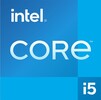Intel Core i5-14501E vs Intel Core i9-9980HK vs Intel Core i7-13700K
Intel Core i5-14501E
► remove from comparison
The Intel Core i5-14501E is a peculiar Raptor Lake family desktop processor (SoC) that has 6 performance cores but 0 efficient cores. It's the lack of E-cores that makes 14X01 chips special.
The product has decently sized level 2 and 3 caches at 12 MB and 24 MB, respectively. Its CPU cores run at up to 5.2 GHz. The UHD 770 serves as the integrated graphics solution. There is no 'proper' NPU here, however, vPro Enterprise features such as RPE (Remote Platform Erase) are onboard.
The i5 chip is manufactured built with the Intel 7 process which is fairly old, as of mid 2025. Its base TDP sits at 65 W which is the standard value for desktop CPUs.
Performance
While we have not tested a single 14X01 processor as of July 2025, we do know that a single 4.6 GHz Raptor Cove core, such as that of an Core i7-14650HX is good for 116 Cinebench 2024 points and 285 Cinebench R15 points. (The 14501E can run at up to 5.2 GHz, too, to remind you.) If we multiply the values by 6, we get a reasonably fair projection that sees the 14501E being about as fast as lower mid-range laptop AMD chips of 2025, such as the AMD Ryzen AI 5 340. While not particularly impressive, this is definitely sufficient for any tasks and applications one could run in 2025, top games included.
Intel Core i9-9980HK
► remove from comparison
The Intel Core i9-9980HK is a high-end processor for laptops with eight cores based on the Coffee Lake architecture (2019 refresh, CFL-HR). The processor clocks at between 2.4 - 5 GHz and can execute up to sixteen threads simultaneously thanks to Hyper-Threading. The 5 GHz can only be reached using the "Thermal Velocity Boost" which allows one core to boost to 5 GHz (+100 MHz) as long as the CPU temperature is below 50°C. Multiple cores can be boosted +100 MHz? below 50°C (not verified). Compared to the predecessor, the Core i9-8950HK, the 9980H is based on the same architecture but offers 2 more cores and higher clock speeds (boost).
According to Intel, the CPU is manufactured in an improved 14nm (14nm++) process. The i9-9980HK is the fastest model of the Coffee-Lake-H (refresh) series at the time of announcement and offers an unlocked multiplier for overclocking of the CPU.
The Coffee Lake architecture is similar to Kaby Lake and differs only in the amount of cores (now max. eight cores for the high end versions) and the improved 14nm process (14nm++ according to Intel).
Performance
Due to the two additional cores, performance has increased by almost 33% compared to a similar clocked 6-core processor. According to first benchmarks, the mobile variant can reach the performance of the Core i9-9900K if the cooling is sufficient.
Graphics
The integrated Intel UHD Graphics 630 iGPU is supposed to offer a slightly higher performance as its clock rate has been increased by 50 MHz. The architecture is identical to that of the Intel HD Graphics 630. We do expect a performance improvement, but as a low-end solution it will probably only display current games smoothly at reduced details - if at all.
Power Consumption
Intel specifies the TDP with 45 watts and therefore the i9 is only suited for big laptops with good cooling solutions.
Intel Core i7-13700K
► remove from comparison
The Intel Core i7-13700K is a high-end CPU based on the current Raptor Lake architecture, which was introduced in September 2022. The base clock is 3.4 GHz and can reach up to 5.4 GHz under optimal conditions. The total of 16 cores are divided into 8 P-cores and 8 E-cores, which we already know from the Alder Lake architecture. Compared to the Intel Core i7-12700K, however, the number of E-cores has been doubled, meaning that the Intel Core i7-13700K now offers 24 threads. As usual, the K models continue to offer a freely selectable multiplier, which simplifies overclocking. In addition, all new Raptor Lake processors can be operated on the existing Socket 1700 motherboards.
Performance
Compared to the Intel Core i7-12700K, the Core i7-13700K still offers 8 P-cores, but these are to be relieved by 8 additional E-cores for demanding applications. The E-cores primarily take care of background applications. The hybrid architecture relies on the Intel Thread Director, which is responsible for the correct allocation of tasks. Compared to Alder Lake, the number of e-cores has been doubled, which significantly improves multi-thread performance in combination with a further increase in IPC. If all requirements are met, Intel Turbo Boost 3.0 can increase the clock rate of the P-cores to up to 5.4 GHz. The E-cores can also be overclocked and reach a maximum of 3.4 GHz.
Graphics
Like the Intel Core i7-12700K, the Intel Core i7-13700K offers an integrated graphics unit (iGPU). The Intel Iris Xe architecture continues to serve as the basis. In terms of performance, however, not much has changed with the new Intel UHD Graphics 770.
Power Consumption
The Intel Core i7-13700K is specified with a TDP of 125 watts, which corresponds to the PL1 value. In Boost mode, the processor's performance can increase to up to 253 watts (PL2). However, this requires good cooling. If all restrictions are deactivated in the BIOS, the PL2 value is not restricted by a Tau value.
| Model | Intel Core i5-14501E | Intel Core i9-9980HK | Intel Core i7-13700K | ||||||||||||||||||||||||||||||||||||||||||||||||||||||||||||||||||||||||||||||||||||||||||||||||||||||||||||||||||||||||||||||||||||||||||||||||
| Codename | Raptor Lake | Coffee Lake-H | Raptor Lake | ||||||||||||||||||||||||||||||||||||||||||||||||||||||||||||||||||||||||||||||||||||||||||||||||||||||||||||||||||||||||||||||||||||||||||||||||
| Series | Intel Raptor Lake-S | Intel Coffee Lake | Intel Raptor Lake-S | ||||||||||||||||||||||||||||||||||||||||||||||||||||||||||||||||||||||||||||||||||||||||||||||||||||||||||||||||||||||||||||||||||||||||||||||||
| Series: Raptor Lake-S Raptor Lake |
|
|
| ||||||||||||||||||||||||||||||||||||||||||||||||||||||||||||||||||||||||||||||||||||||||||||||||||||||||||||||||||||||||||||||||||||||||||||||||
| Clock | 3300 - 5200 MHz | 2400 - 5000 MHz | 3400 - 5400 MHz | ||||||||||||||||||||||||||||||||||||||||||||||||||||||||||||||||||||||||||||||||||||||||||||||||||||||||||||||||||||||||||||||||||||||||||||||||
| L2 Cache | 12 MB | 2 MB | 24 MB | ||||||||||||||||||||||||||||||||||||||||||||||||||||||||||||||||||||||||||||||||||||||||||||||||||||||||||||||||||||||||||||||||||||||||||||||||
| L3 Cache | 24 MB | 16 MB | 30 MB | ||||||||||||||||||||||||||||||||||||||||||||||||||||||||||||||||||||||||||||||||||||||||||||||||||||||||||||||||||||||||||||||||||||||||||||||||
| Cores / Threads | 6 / 12 6 x 5.2 GHz Intel Raptor Cove P-Core | 8 / 16 | 16 / 24 8 x 5.4 GHz Intel Raptor Cove P-Core 8 x 3.4 GHz Intel Gracemont E-Core | ||||||||||||||||||||||||||||||||||||||||||||||||||||||||||||||||||||||||||||||||||||||||||||||||||||||||||||||||||||||||||||||||||||||||||||||||
| TDP | 65 Watt | 45 Watt | 125 Watt | ||||||||||||||||||||||||||||||||||||||||||||||||||||||||||||||||||||||||||||||||||||||||||||||||||||||||||||||||||||||||||||||||||||||||||||||||
| Technology | 10 nm | 14 nm | 10 nm | ||||||||||||||||||||||||||||||||||||||||||||||||||||||||||||||||||||||||||||||||||||||||||||||||||||||||||||||||||||||||||||||||||||||||||||||||
| Socket | LGA1700 | FCBGA1440 | LGA 1700 | ||||||||||||||||||||||||||||||||||||||||||||||||||||||||||||||||||||||||||||||||||||||||||||||||||||||||||||||||||||||||||||||||||||||||||||||||
| Features | DDR4-3200/DDR5-4800 RAM, PCIe 5 + PCIe 4, DL Boost, GNA, vPro En., RPE, MMX, SSE, SSE2, SSE3, SSSE3, SSE4.1, SSE4.2, AVX, AVX2, BMI2, ABM, FMA, ADX, SMEP, SMAP, EIST, TM1, TM2, HT, Turbo, SST, AES-NI, RDRAND, RDSEED, SHA | Dual-Channel DDR4 Memory Controller, HyperThreading, AVX, AVX2, Quick Sync, Virtualization, AES-NI | Intel UHD Graphics 770, DDR5 5600 MT/s, DDR4 3200 MT/s | ||||||||||||||||||||||||||||||||||||||||||||||||||||||||||||||||||||||||||||||||||||||||||||||||||||||||||||||||||||||||||||||||||||||||||||||||
| iGPU | Intel UHD Graphics 770 ( - 1550 MHz) | Intel UHD Graphics 630 (350 - 1250 MHz) | Intel UHD Graphics 770 (300 - 1600 MHz) | ||||||||||||||||||||||||||||||||||||||||||||||||||||||||||||||||||||||||||||||||||||||||||||||||||||||||||||||||||||||||||||||||||||||||||||||||
| Architecture | x86 | x86 | x86 | ||||||||||||||||||||||||||||||||||||||||||||||||||||||||||||||||||||||||||||||||||||||||||||||||||||||||||||||||||||||||||||||||||||||||||||||||
| Announced | |||||||||||||||||||||||||||||||||||||||||||||||||||||||||||||||||||||||||||||||||||||||||||||||||||||||||||||||||||||||||||||||||||||||||||||||||||
| Manufacturer | www.intel.com | www.intel.de | |||||||||||||||||||||||||||||||||||||||||||||||||||||||||||||||||||||||||||||||||||||||||||||||||||||||||||||||||||||||||||||||||||||||||||||||||
| L1 Cache | 512 KB | ||||||||||||||||||||||||||||||||||||||||||||||||||||||||||||||||||||||||||||||||||||||||||||||||||||||||||||||||||||||||||||||||||||||||||||||||||
| max. Temp. | 100 °C | 100 °C | |||||||||||||||||||||||||||||||||||||||||||||||||||||||||||||||||||||||||||||||||||||||||||||||||||||||||||||||||||||||||||||||||||||||||||||||||
| Die Size | 257 mm2 | ||||||||||||||||||||||||||||||||||||||||||||||||||||||||||||||||||||||||||||||||||||||||||||||||||||||||||||||||||||||||||||||||||||||||||||||||||
| $409 U.S. |
Benchmarks
Average Benchmarks Intel Core i9-9980HK → 0% n=0
Average Benchmarks Intel Core i7-13700K → 0% n=0
* Smaller numbers mean a higher performance
1 This benchmark is not used for the average calculation













